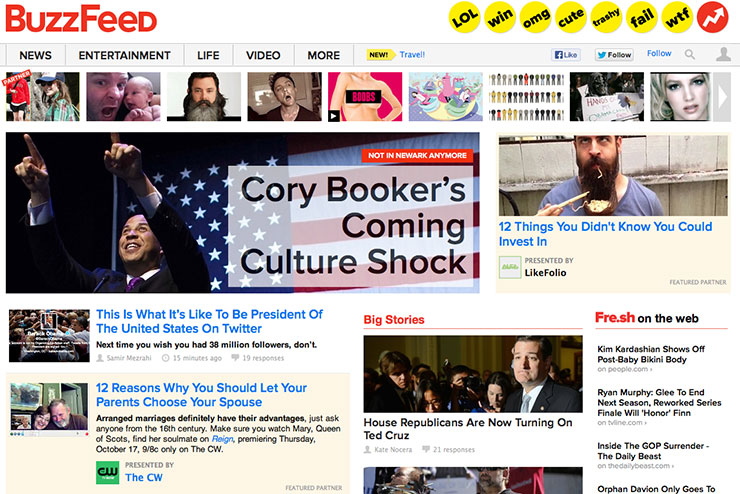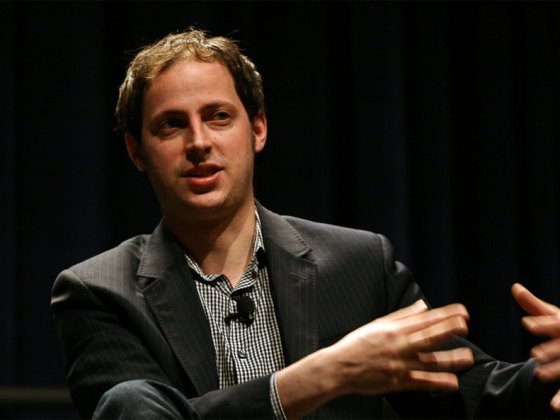“Obama Asks The Hill To Bomb Syria, As Explained By ‘The Hills.’”
“There Is Some Random Guy Mowing The Lawn Of The Lincoln Memorial Right Now.”
“18 Forgotten ’90s One-Hit Wonders.”
You know a BuzzFeed headline when you see one. Not the newsiest stuff.
Yet, hard news is where the social content website – best known for its endless animal GIFs, celebrity gossip and 1990s nostalgia – has been heading for the past year. BuzzFeed has added breaking news and long form to its classic mix of listicles (lists + articles).
“Despite the struggles of the traditional media, there remains an insatiable desire for great reporting, entertaining content and powerful storytelling,” founder Jonah Peretti wrote in a public memo in September. “The world needs sustainable, profitable, vibrant content companies staffed by dedicated professionals; especially content for people that grew up on the web.”
As part of its move to provide newsier content, the site hired New York Times editor Lisa Tozzi as its news director.
“People like entertainment, and they like information. People think, ‘Oh, BuzzFeed, the cat GIF people, are doing news,’” said Tozzi, who joined BuzzFeed in April and leads a team of 14 breaking-news reporters. “The New York Times has a style section and an entertainment section. People who read the Times don’t say, ‘I only read the foreign news.’ They read everything.”
It’s about having variety on the front page, Tozzi said. “You want to mix it up and have a sample of different things for people to read and have an opportunity to be well-rounded intelligent people.”
In this way, BuzzFeed is looking to provide readers with both entertaining posts for which the site is known and important journalistic content – breaking news, foreign reports, investigations – aimed at young people that is absent from print newspapers, Peretti wrote.
People come for the cats, but stay for the news. Why?
It starts with those headlines. Who can refuse to click on “Awkward Moments You Wish You Could Teleport Out Of”? “Incredibly Important Photos Of Anderson Cooper With Boo The Pomeranian” is just begging to be read.
Sometimes oddball, always intriguing, BuzzFeed headlines have even become a point of self-parody. Most of them contain a number and almost always promise some kind of emotional response.
“They’re things that promise answers or things that engage your emotion,” said media psychologist Pamela Rutledge, director of the Media Psychology Research Center and an adjunct faculty member at the Massachusetts School of Professional Psychology in Newton, Mass.
And although the articles are about politics, they make a commentary about people, “which works pretty well because people are interested in other people, even if you don’t know them,” Rutledge said. “You can’t help yourself.”
Online content producers sometimes have less than a second to catch a reader’s interest.
Our brains notice things that are unusual to us, Rutledge said, and BuzzFeed’s headlines and unusual content rely on this.
“The headlines promise sensational stories ‘LGBT Rally In St. Petersburg Ends With Arrests And Violence’ or ‘Taliban Vows To Again Try And Kill 16-Year-Old Malala Yousafzai,’” she said. “Yes, they are news – although, by definition, anything that happens we didn’t know about is news – but they are news at the outer edge of our expectations.”
This curiosity is what keeps people clicking, she said. We anticipate a surprise in a BuzzFeed article that other sites might not deliver. Sometimes we’re disappointed, but there’s still a chance for a reward.
The brain also processes visual images much differently than text.
“Images communicate more holistically, and they trigger connections to our previous experiences and beliefs at unconscious levels, long before we make sense out of them consciously,” she said.
BuzzFeed’s strategy appears to be working. The company has 120 editorial staff, according to a company spokesperson, and the site recently listed job openings for a deputy foreign editor, an investigations editor and a national security reporter.
BuzzFeed ranked 24th as the most visited site on the web in September, logging 55 million unique visitors in the United States, according to data from Quantcast, a digital advertising company that measures analytics around the web. Google was No. 1 in Quantcast’s U.S. rankings, and only two news sites ranked higher than BuzzFeed: NBC News (21st) and Huffington Post (15th). BuzzFeed had 85 million unique global visitors.
The site is also earning money, Peretti has been reported as saying, and investing it in new media formats – beyond the list.
“We will always do lists, but we have the advantage of not being limited to a single format like many traditional media companies,” Peretti wrote. “We do long form, short form, quizzes, video, original graphic art, rubbable gifs, apps and more. In the coming years, we will continue our R&D focused on inventing and advancing media formats.”
As for the form breaking news should take, “short, smart nuggets of news that get to what people should know quickly are helpful,” Tozzi said.
And those lists? Lists have always been part of any great communicator’s potential bag of tricks. They’re digestible and helpful for breaking down complex stories. Think of the Ten Commandments and the Declaration of Independence, some of the most famous lists of all.
“People like different ways for consuming their news,” Tozzi said. “Reading 2,000-word story after 2,000-word story can get hard after a while, so it’s good to change things up” with lists and other formats.
“They’re harder to do than people think.”







You must be logged in to post a comment.